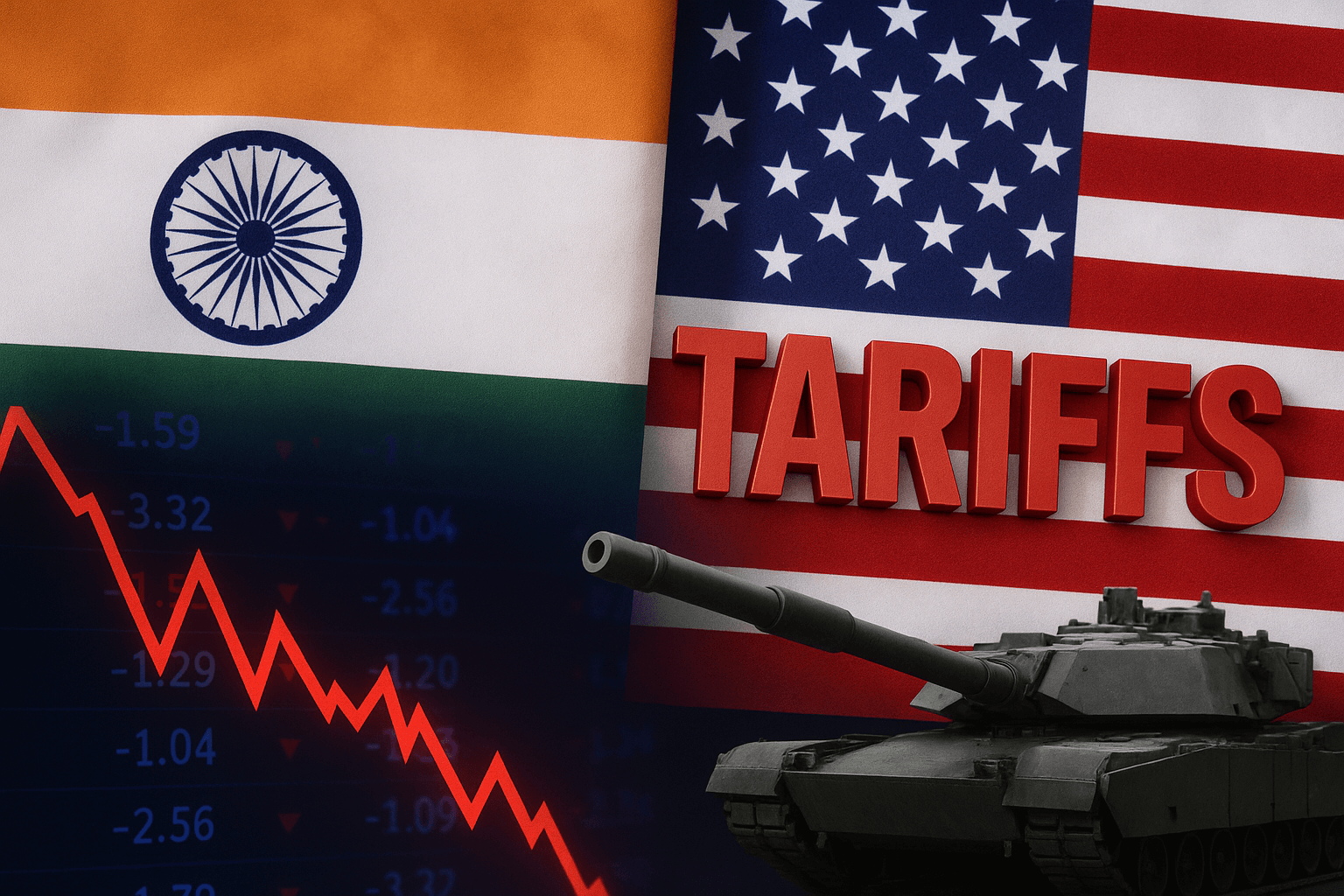1) India pushes back after sudden U.S. tariffs — defence purchases paused, markets jitter
This week New Delhi signalled a firm response to a surprise U.S. tariff move that targeted Indian imports. Reports say Washington imposed sharp, broad tariffs, prompting immediate market turbulence in India (rupee weakness, commodity swings) and diplomatic strain. In a fast follow-up, India reportedly paused planned weapons and aircraft purchases from the U.S. and delayed an expected defence visit — a clear signalling that trade policy can spill directly into strategic ties. For ordinary Indians, the tariff shock has immediate meaning: exporters and manufacturers face uncertainty, the rupee saw pressure, and policy-makers must balance economic pain with geopolitical priorities. Analysts say New Delhi will likely pursue a dual-track approach — protect export sectors while opening high-level talks to defuse the shock — though much depends on how Washington moves next. Businesses will be watching any tariff clarifications closely; for readers, expect a short-term hit to investor sentiment and potential reshoring conversations in supply chains. The Economic TimesAl Jazeera
2) Israel approves phased plan to seize Gaza City — international alarm grows
Israel’s security cabinet approved a phased operation reportedly aimed at seizing control of Gaza City, a dramatic escalation after nearly two years of conflict. The plan — which officials say focuses on key urban objectives rather than full permanent governance — triggered immediate international concern over civilian safety, displacement and humanitarian access. Aid groups warned of catastrophic consequences as food, water and medical supplies remain scarce in many parts of the enclave; reports of hunger-related deaths and civilians refusing to leave their homes highlighted the human cost. Israel says the move targets Hamas’s command nodes and aims to secure hostage releases, but critics and several European governments urged restraint and de-escalation, with some suspending military equipment transfers. The delicate balance between military objectives and humanitarian protection is now under intense global scrutiny; diplomatic channels will be busy in the coming days as regional and global actors push for safeguards and ceasefire diplomacy. The Wall Street JournalAl JazeeraThe Guardian
3) Gaza’s humanitarian crisis deepens — starvation and displacement headline coverage
Alongside military plans, reporting this week emphasised a worsening humanitarian picture in Gaza: growing numbers of hunger-related deaths, mass displacement and attacks on aid convoys. Journalists and health officials described crowded camps, limited medical supplies, and the challenge of reaching besieged urban neighborhoods. Humanitarian agencies warned that any major ground operation in Gaza City would likely displace hundreds of thousands more and could push conditions toward a full-scale relief emergency. International pressure mounted on all sides to enable sustained, safe corridors for food, water and medicine; meanwhile, calls for third-party mediation to secure hostage releases and humanitarian pauses intensified. For readers, this story is a reminder that headlines about strategy and territory have immediate human consequences — and that relief logistics, donor responses, and diplomatic channels will shape how the crisis unfolds over weeks, not days. Al Jazeera
4) Russia’s campaign in Ukraine: incremental gains, sustained missile and drone strikes
Military analysts continued to track incremental Russian advances in parts of eastern Ukraine this week, with think-tanks documenting offensives and a high tempo of drone and missile attacks across multiple fronts. Assessments pointed to expanded Russian production of long-range strike assets — enabling sustained pressure on Ukrainian logistics and urban centers — while Ukrainian forces reported tactical adjustments to blunt advances. The fighting remains attritional: control of some towns shifted or became contested, but both sides appear dug in for a prolonged campaign. The international security community watched for impacts on energy and grain exports, given how continued hostilities can reverberate in commodity markets. For readers, the key takeaway is that the conflict remains active and fluid; expect continued coverage of frontline shifts, civilian impacts, and diplomatic efforts to sustain support packages and sanctions enforcement. Institute for the Study of War+1Al Jazeera
5) Global summer of extremes: heatwaves, Arctic records and wildfires
Scientists and climate reporters flagged another week of extreme heat, with new temperature records, heat-related impacts on wildlife (reports of reindeer deaths in the Arctic), and wildfires across parts of Europe. Northern latitudes, usually cooler, experienced unusual surges that stress infrastructure and ecosystems; meanwhile, regions from Japan to southern Europe recorded dangerous highs. Carbon Brief and other outlets framed this as part of a broader pattern this summer — a “cavalcade of climate extremes” — with experts warning that such clustered events will become more common unless emissions are rapidly curtailed and adaptation planning is scaled up. For everyday readers, the implications are immediate: more health advisories, strain on power grids, harvest and supply disruptions, and renewed pressure on governments to translate climate commitments into tangible resilience measures. Deutsche WelleCarbon BriefPhys.org
6) China’s economic signals cause concern — overcapacity, falling price pressures
Reports this week pointed to deeper structural issues in China’s economy: persistent deflationary signals, overcapacity in manufacturing and real estate pressure that together erode corporate profits and dent investor confidence. Analysts warned that falling factory-gate prices and a prolonged GDP-deflator decline may force Beijing into a delicate policy balancing act — stimulate growth without re-igniting debt bubbles in property or local government financing. Global supply chains and commodity markets are sensitive to China’s demand outlook, so weaker industrial activity there can ripple outward, hitting exporters and raw-material producers. For businesses and readers, the practical lens is clear: slower Chinese demand could change export prospects for many countries and force investors to reprice growth expectations for the rest of 2025. The Guardian
7) Markets jitter after political shocks — safe-havens rally while risk assets wobble
This week’s policy shocks and geopolitical escalations pushed investors toward safe-haven assets: gold saw gains and certain commodity prices moved as traders weighed tariffs, sanctions risks and regional instability. Emerging market currencies — notably the Indian rupee — came under pressure after the tariff news and broader risk-off flows. Equity indices in some regions trimmed gains as uncertainty rose about near-term trade flows and supply-chain disruptions. Central banks and finance ministries will be monitoring volatility: they may step in with liquidity operations or verbal reassurances to steady markets. For readers tracking their savings and investments, the practical suggestions remain to review asset allocation, avoid panic selling, and keep an eye on official statements that can calm or further rattle markets. The Economic TimesPhys.org
8) US judicial developments and domestic policy fights remain in focus
In the United States this week, federal courts issued rulings affecting major executive actions, including a nationwide injunction related to a birthright citizenship directive — a decision that will likely feed into national debates and prospective legal appeals. Meanwhile, political columns and polling highlighted voter concerns about leadership and age, keeping the 2024–2025 political calendar lively and the legal system central to governance questions. What this means on the ground is a longer legal path for contested policies and continued back-and-forth between executive orders and judicial review — an area that watchers say will remain a prominent news driver as the next electoral cycle approaches. For international audiences, US domestic legal shifts often influence global markets and diplomatic posture, so they bear watching. Fox NewsThe Guardian
9) France and wider Europe battle wildfires and climate-driven emergencies
European nations reported an intense fire season in parts of France and southern Europe, with fire services stretched and authorities issuing evacuation orders in affected areas. The wildfire outbreaks, paired with heatwaves, worsen air quality and threaten crops and tourism zones. Emergency planning, cross-border firefighting aid and climate adaptation measures are now front-and-center in national debates about resilience and land management. For readers in or connected to Europe, the immediate concerns are health advisories, travel disruptions, and local relief appeals; for global readers, these episodes are another data point in escalating climate impacts that affect food security and economic recovery in tourism-dependent regions. Carbon BriefDeutsche Welle

10) Culture & tech: platforms under scrutiny as controversies keep resurfacing
Across social platforms, creator controversies and content moderation debates continued to bubble — from high-profile videos and panel shows that drew FIRs to influencer apologies that sparked wider discussion about tone and responsibility. Regulators and courts in multiple countries are watching platform behaviour, moderation transparency, and the legal consequences of hosted content. For readers, this is a reminder that digital culture is not only entertainment but a civic space where norms, law and commerce intersect. Expect more regulatory scrutiny in 2025 as governments press platforms for clearer rules on harmful content, takedowns and accountability. The Wall Street JournalAl Jazeera




